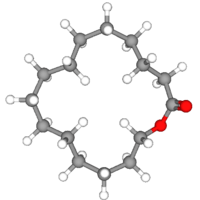Cyclopentadecanolide
 | |
 | |
| Names | |
|---|---|
| IUPAC name
Oxacyclohexadecan-2-one | |
| Other names
Angelica lactone; Muskalactone; Muskolactone; Exaltolide; Pentalide; Pentadecanolide; Pentadecalactone; 15-Hydroxypentadecanoic acid, lactone; 15-Hydroxypentadecanoic acid-epsilon-lactone; Pentadecanoic acid, 15-hydroxy-, E-lactone; ω-Pentadecalactone; omega-Pentadecalactone; ω-Lactone; 2-Pentadecalone; Pentadecan-15-olide; 1,15-Pentadecanolide | |
| Identifiers | |
| 106‐02‐5 | |
| 3D model (Jmol) | Interactive image |
| ChemSpider | 205386 |
| EC Number | 203‐354‐6 |
| PubChem | 235414 |
| |
| |
| Properties | |
| C15H28O2 | |
| Molar mass | 240.39 g·mol−1 |
| Appearance | colorless crystals |
| Odor | musklike |
| Density | 0.940 |
| Melting point | 37 to 38 °C (99 to 100 °F; 310 to 311 K) |
| Boiling point | 169 °C (336 °F; 442 K) |
| Except where otherwise noted, data are given for materials in their standard state (at 25 °C [77 °F], 100 kPa). | |
| Infobox references | |
Cyclopentadecanolide is a natural macrolide lactone and a synthetic musk.
Natural occurrence
Cyclopentadecanolide occurs in small quantities in angelica root essential oil and is responsible for its musklike odor.[1]
Production
Cyclopentadecanolide is produced synthetically by ring expansion of cyclododecanone. Another synthesis route is the depolymerization of polyesters of 15-hydroxypentadecanoic acid.[1]
Uses
Cyclopentadecanolide is used as a musklike perfume fixative in fine fragrances and as a flavoring agent.[2] It is a substitute for the extremely expensive animal musk.[1]
References
- 1 2 3 Karl-Georg Fahlbusch; et al. (2007), "Flavors and Fragrances", Ullmann's Encyclopedia of Industrial Chemistry (7th ed.), Wiley, p. 75
- ↑ George A. Burdock (2010), "ω-PENTADECALACTONE", Fenaroli's Handbook of Flavor Ingredients (6th ed.), Taylor & Francis, p. 1597
This article is issued from Wikipedia - version of the 12/27/2015. The text is available under the Creative Commons Attribution/Share Alike but additional terms may apply for the media files.